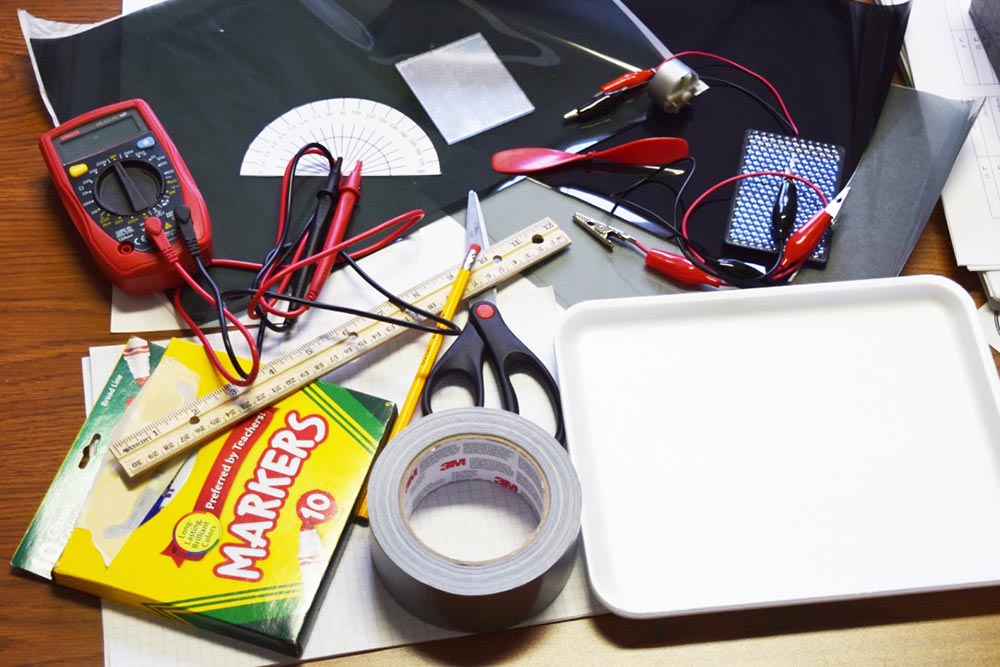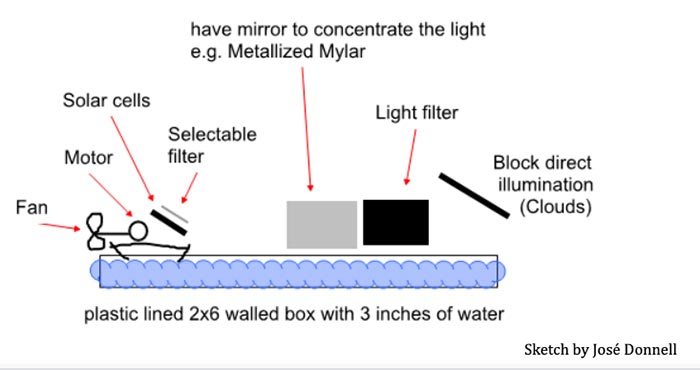Activity 6: Engineering Solar Powered Boats
Learning Targets:
- Understand how energy from the sun transfers into electrical and mechanical energy.
- Design and construct a solar-powered boat.
- Use the engineering design process to determine the best design and potential modifications for optimal design.
Length: 60-80 minutes
Essential Questions:
- How can solar energy be transferred to another form of energy?
- How does engineering design impact maximum energy collection?
- How can we construct a model boat that is propelled by solar energy?
Enduring Understandings:
- The engineering design process is an effective way to find a solution to maximize power for building a boat.
- Solar energy can be captured and transferred to mechanical energy to move a boat.
- Solar energy collection can be maximized through the engineering design process.
NGSS Standards:
- MS-PS3-3, MS-ETS1-1, MS-ETS1-2, MS-ETS1-4
Background for Facilitator
This activity introduces using solar energy to move a boat across the water. This activity can be done in sequence with the rest of this curriculum, or as a stand-alone activity. If water is not easily accessible, you may consider testing designs on another flat, even surface. You may want to have youth work in small groups, or independently.
These boats use solar photovoltaic systems to power them. Solar photovoltaic systems convert sunlight into electricity. Solar photovoltaic (PV) devices, or solar cells, change sunlight directly into electricity. Small PV cells can power calculators, watches, and other small electronic devices. Arrangements of many solar cells in PV panels and arrangements of multiple PV panels in PV arrays can produce electricity for an entire house. Some PV power plants have large arrays that cover many acres to produce electricity for thousands of homes.
The two main benefits of using solar energy: Energy systems do not produce air pollutants or carbon dioxide. Solar energy systems on buildings have minimal effects on the environment. The main limitations of solar energy: The amount of sunlight that arrives at the earth’s surface is not constant. The amount of sunlight varies depending on location, time of day, the season of the year, and weather conditions. The amount of sunlight reaching a square foot of the earth’s surface is relatively small, so a large surface area is necessary to absorb or collect a useful amount of energy.
Facilitators and youth may also watch the video Maine 4-H Solar Energy Project with RLC Engineering 5422 (YouTube).
Limitations of solar energy are highlighted at minute marker 10:31-12:49 and benefits of solar energy are highlighted from marker 12:49-13:48.
Youth should have the opportunity to engage in the engineering design process and modify their design if they choose. As the facilitator, it will be especially important to ask purposeful questions about their designs, such as why they chose a certain modification and what the function of that modification might be. Encourage youth to explain why they are making design choices. If a design does not work how they expect, what might they change? This will encourage independence and discovery.
Safety tip: Youth should be told not to look directly at the sun.
Vocabulary List:
- Circuit: A device that provides a path for electric current to flow
- Thermal Energy: heat energy
- Radiant Energy: light energy
- Reflection: bouncing energy back without absorbing it
- Absorption: take in heat energy
- Solar panel: collect sunlight and change radiant energy into electricity
- Engineering Design: a series of steps to create a product, includes ask, imagine, plan, create, improve
- Solar Energy: Energy that comes directly from the sun
- Voltage: the difference in energy between two points
- Engineering Design: a series of steps to create a product, includes ask, imagine, plan, create and improve
Materials:
- Blank paper
- Markers
- Multimeter and alligator clips (optional)
- ProtractorSolar Panel cell (or appropriate for the motor), with wires
- Foam trays (~4”x10” per boat)
- Mirror
- Solar Boats Observation and Data Sheet
- Clipboards
- Pencils
- Access to direct sunlight
- Scissors
- DC motor (1 per boat)
- Small plastic fan (to attach to each boat)
- Duct tape
- Large aluminum trays or small pool
- Access to water
- Graph paper
- Pencils

Methods:
Engage:
Discuss as a group what was discovered during Activity 1, Introduction of Solar Energy. What do participants remember about testing solar panels – what designs captured the most energy and what designs captured the least amount of energy?
Note: if using this as a stand-alone activity and youth have not done Activity 1 instead ask youth what they know about solar energy? Have they seen solar panels before? Have them describe where they’ve seen them, what they look like and what they think they might be used for. What are some of the benefits of using solar? What might be some of the challenges?
Explain that during this session we are going to use what we learned about solar cells and the transfer of energy to build a boat that will be powered by a single solar cell.
Explore:
Be sure to be in the sunlight (or a high-power spotlight) when testing.
- Explain to the youth that today they are going to build a boat powered by solar. The goal is to have the boat travel the greatest distance across the water (or flat surface if water is not available). Introduce participants to the materials that will be available to them. Each person (or team of two) will get materials to build one boat. Basic materials include foam insulation, motor, propeller, solar panel, wires to attach the panel to the motor, and adhesive tape.
- Provide youth with graph paper and pencils and ask them to sketch their boat design.
- When they are done sketching, have the youth explain their design to the facilitator, who can ask reflection questions about attachment, placement of pieces, and overall design. When the facilitator approves the design, participants may get their materials and move on to constructing their boat.
- Provide youth with time to build their initial design. Encourage individuals and teams to share with others their designs as they build.
- Designs will be tested for the first time as a whole group. Ask youth how they will know if their boat is successful? Are there any data that should be collected as they test? Take time to brainstorm this and ask youth to take note of the data for their individual design when it’s tested. A sample data sheet is provided in the appendix to be used if there is no time to generate one with the group.
- When groups are ready to test the initial design, have individuals introduce and explain their boat design to the entire group. After explaining, they may test in the water. Be sure your water test system (foil pan or small pool) is in the direct sun, or the solar panels may not work.
- Ask individuals to identify what they observe after testing their initial boat design. Are there any similarities or differences between boat designs? How will they know if they are able to improve their designs? Is there additional data that could be collected to support this?
- Youth should connect their design to the multimeter to measure voltage output from the fan.
Elaborate
As time permits, allow youth to redesign their boats to meet maximum energy production. It is important as the facilitator to let youth guide their own redesign as much as possible. Facilitators can use questions about design to provide guidance as needed (ex. What is the challenge you are trying to address? Tell me what you see there now? What could you change? What did you notice about X person’s design? Is there something you could use from observing that)? Common challenges might include a limited collection of solar energy (adjust solar panel angle, height, or attachment), boats that spin in one direction, and/or boats that do not sit level on the water. Facilitators can highlight to groups that the fan is directly affected by the light brightness. The strength of the light is proportional to the motor’s response.
Evaluate
Engage youth in a discussion about their experience. Encourage youth to use evidence from their observations or the data sheet when making their claims. Questions might include:
- How did you feel when you tested your boat?
- What did you think was going to happen when you tested your boat?
- Did anything surprise you during this activity?
- How did you decide who was going to do what in your group?
- What did you observe?
- What did you discover about capturing energy? Were there designs that worked better than others?
- Did your background knowledge influence your design?
- How did the sunlight or darkness impact the fan or any other use for the solar-powered motor? Use evidence to support your claim(s).
- What designs seemed to have the fastest boat? Why do you think that those boat(s) were faster than others? What could have impacted speed and design function? Use evidence to support your claim(s).
- What skills did you discover or use while working on this?
- How might you use the idea of solar power to apply to another design or real-world application?
Extension Ideas
- Design a ‘course’ in the water testing pool. The course should allow the student to race the boats. The variance in the course will be compensated by the angle of the cells on the boats. Through the course, different surfaces can be used to affect the boat’s performance. The students then can figure out the best mounting to take advantage of the conditions. The course can be short plastic-lined wooden troughs. The course would be set up similarly to the following sketch. The boats should have criteria that limit the contestants but allow for variations in size, shape, etc. however they should be small.
- Use the boat and modify it for better performance for a second run.
- Test the boats with various filters on the solar cells to modify power output.
- How important was direct sunlight – diffused light – reflected light?
- How well did the design allow for brief moments of blocked or filtered sunlight (artificial clouds)Use shaded filters (define these) to put over the panel and see how they impact the function of the solar panel. While filters are not used in real practice with solar panels, they can simulate real-world scenarios that impact the light absorbed by the panels. Filters hold radiant wavelengths out and the color is different radiation frequencies. Explain that filters can reduce the radiance, or energy, reaching the panel For example, if shade from a cloud or surrounding tree or structure would still allow indirect light to reach the panel, but would limit the direct sunlight. Another example might include light reflected off snow or grass, which is absorbed differently by solar panels than the direct rays of sunlight.

